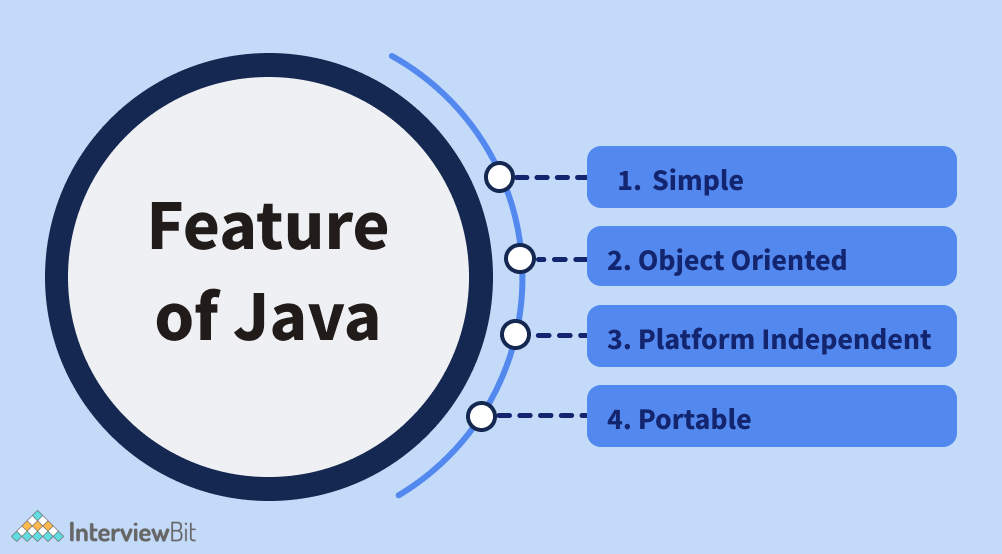- Introduction
- Why is Java so Popular?
- Why Use Java?
- Top 8 Java Features You Must Know
- 1. Simple
- 2. Object-Oriented
- 3. Platform Independent
- 4. Portable
- 5. Robust
- 6. Secure
- 7. Interpreted
- 8. Multi-Threaded
- Conclusion
- Frequently Asked Questions
- Q.1: What is the most important feature of Java?
- Q.2: What are the main uses of Java?
- Q.3: How is Java useful in real life?
- Q.4: What is the scope of Java?
- Q.5: Why doesn’t Java support Pointers?
- Additional Resources
Introduction
Java is a high-level and purely object oriented programming language. It is platform independent, robust, secure, and multithreaded programming language which makes it popular among other OOP languages. It is widely used for software, web, and mobile application development, along with this it is also used in big data analytics and server-side technology. Before moving towards features of Java, let us see how Java originated.
In 1990, Sun Microsystems Inc. started developing software for electronic devices. This project was called the Stealth Project (later known as Green Project). In 1991, Bill Joy, James Gosling, Mike Sheradin, and Patrick Naughton started working on this project. Gosling decided to use C++ to develop this project, but the main problem he faced is that C++ is platform dependent language and could not work on different electronic device processors. As a solution to this problem, Gosling started developing a new language that can be worked over different platforms, and this gave birth to the most popular, platform-independent language known as Oak. Yes, you read that right, Oak, this was the first name of Java. But, later it was changed to Java due to copyright issues (some other companies already registered with this name). But why “Java” though? Let’s see the story behind this name Java and its logo which is a coffee mug. See the image below.
On 23 January 1996, Java’s JDK 1.0 version was officially released by Sun Microsystems. This time the latest release of Java is JDK 17.0 (September 2021). Now Java is being used in Web applications, Windows applications, enterprise applications, mobile applications, etc. Every new version of Java comes with some new features.
Confused about your next job?
Why is Java so Popular?
The first and foremost reason is the platform-independent feature of Java. Platform independence means programmers who developed their software in one platform can execute it on any platform or operating system regardless of underlying configuration, because of Java Virtual Machine. In other words, we can say that Java follows the WORA rule which says Write Once Run Anywhere. Besides that Java provides security over eavesdropping, tampering, impersonation, and virus threat. Java also provides a multi-threading feature through which we can create multiple threads under any process which works independently and simultaneously.
Other than these, the performance of Java is also impressive. It uses JIT(Just In Time Compiler) that is capable of compiling only that method which is being called and not the whole program. This saves a lot of time and makes overall development efficient. Due to its high performance, Java has a wide variety of applications. Java is one of the oldest programming languages used for the development of android applications. It is also used for scientific and web applications. These all made Java so popular.
Why Use Java?
Java is easy to learn for programmers. Most people pick Java as their first programming language. Moreover, the popularity of Java still persists in the industry. Most of the government, healthcare, defence, and education sector websites, and applications are still using Java technologies. So, it is worth learning and using Java. If you see Java as a career option then also it can take you to various career paths. Almost everything you can do using Java.
Top 8 Java Features You Must Know

1. Simple
Java is a simple programming language and easy to understand because it does not contain complexities that exist in prior programming languages. In fact, simplicity was the design aim of Javasoft people, because it has to work on electronic devices where less memory/resources are available. Java contains the same syntax as C, and C++, so the programmers who are switching to Java will not face any problems in terms of syntax. Secondly, the concept of pointers has been completely removed from Java which leads to confusion for a programmer and pointers are also vulnerable to security.
2. Object-Oriented
Java is an Object Oriented Programming Language, which means in Java everything is written in terms of classes and objects. Now, what is an Object? The object is nothing but a real-world entity that can represent any person, place, or thing and can be distinguished from others. Every object near us has some state and behaviour associated with it.
For example, my mobile phone is a real-world entity and has states like colour, model, brand, camera quality, etc, and these properties are represented by variables. Also mobile is associated with actions like, calling, messaging, photography, etc and these actions are represented by methods in Java.
Now, we saw what an object is and also learned about the state and behaviour associated with the object.
What is Class? A collection of objects that exhibits the same state and behavior will come under the same group called class. For example, Samsung, Apple, Vivo, Oppo, Xiaomi, etc are different brands making various models of smartphones, but they all come under the same group known as Mobile Phones.
The main concepts of any Object Oriented Programming language are given below:
- Class and Object
- Encapsulation
- Abstraction
- Inheritance
- Polymorphism
3. Platform Independent
The design objective of javasoft people is to develop a language that must work on any platform. Here platform means a type of operating system and hardware technology. Java allows programmers to write their program on any machine with any configuration and to execute it on any other machine having different configurations.
In Java, Java source code is compiled to bytecode and this bytecode is not bound to any platform. In fact, this bytecode is only understandable by the Java Virtual Machine which is installed in our system. What I meant to say is that every operating system has its own version of JVM, which is capable of reading and converting bytecode to an equivalent machine’s native language. This reduces the overhead of programmers writing system-specific code. Now programmers write programs only once, compile them, generate the bytecode and then export it anywhere.
4. Portable
The WORA (Write Once Run Anywhere) concept and platform-independent feature make Java portable. Now using the Java programming language, developers can yield the same result on any machine, by writing code only once. The reason behind this is JVM and bytecode. Suppose you wrote any code in Java, then that code is first converted to equivalent bytecode which is only readable by JVM. We have different versions of JVM for different platforms. Windows machines have their own version of JVM, Linux has its own and macOS has its own version of JVM. So if you distribute your bytecode to any machine, the JVM of that machine would translate the bytecode into the respective machine code. In this way portability lets the programmers focus on development and productivity rather than writing different code for different platforms.
5. Robust
The Java Programming language is robust, which means it is capable of handling unexpected termination of a program. There are 2 reasons behind this, first, it has a most important and helpful feature called Exception Handling. If an exception occurs in java code then no harm will happen whereas, in other low-level languages, the program will crash.
Another reason why Java is strong lies in its memory management features. Unlike other low-level languages, Java provides a runtime Garbage collector offered by JVM, which collects all the unused variables. The garbage collector is a special program under JVM that runs from time to time and detects any unused variables and objects and removes them from the memory to free up space. But in the case of other prior languages, there is no such program to handle memory management, programmers are solely responsible for allocating and deallocating memory spaces, otherwise, the program may crash due to insufficient memory
6. Secure
In today’s era, security is a major concern of every application. As of now, every device is connected to each other using the internet and this opens up the possibility of hacking. And our application built using java also needs some sort of security. So Java also provides security features to the programmers. Security problems like virus threats, tampering, eavesdropping, and impersonation can be handled or minimized using Java. Encryption and Decryption feature to secure your data from eavesdropping and tampering over the internet. An Impersonation is an act of pretending to be another person on the internet. The solution to
The impersonation problem is a digital signature, a file that contains personal identification information in an unreadable format. Digital Signature can be generated using Java. Virus is a program that is capable of harming our system and this is generally spread with .exe files, image files, and video files but cannot be spread using a text file the good thing is java bytecode is also a text file (yes .class file also a text file with non-human-readable format). Even if somebody tries to add virus code in a bytecode file, then also we are safe, because our JVM is smart enough to distinguish viruses from normal programs. If a virus is found in a bytecode file, JVM will throw an exception and abort execution.
7. Interpreted
In programming languages, you have learned that they use either the compiler or an interpreter, but Java programming language uses both a compiler and an interpreter. Java programs are compiled to generate bytecode files then JVM interprets the bytecode file during execution. Along with this JVM also uses a JIT compiler (it increases the speed of execution).
8. Multi-Threaded
Thread is a lightweight and independent subprocess of a running program (i.e, process) that shares resources. And when multiple threads run simultaneously is called multithreading. In many applications, you have seen multiple tasks running simultaneously, for example, Google Docs where while typing text, the spell check and autocorrect tasks are running.
The server also uses multithreading to provide its services to multiple client requests. In Java, you can create threads in two ways, either by implementing the Runnable interface or by extending the Thread class.
Conclusion
In this article, we have discussed the design aim of Java i.e, James Gosling wants to develop Java as a system-independent language that must work on the WORA (Write Once Run Anywhere) principle. We also have learned the top features of Java, which makes java the most popular among other programming languages. By now, you must have got a glimpse of Java. Along with all this, we also discussed problems in C++, which have been resolved in Java.
Frequently Asked Questions
Q.1: What is the most important feature of Java?
Answer: The most important features of Java are Platform Independent and Object Oriented. That’s why Java is the most popular among high-level programming languages.
Q.2: What are the main uses of Java?
Answer: Since Java is distributed and system independent, it can be used anywhere like:
- Web Development
- Software Development
- Mobile Application Development
- Distributed Applications
- Web servers
- Enterprise Application
Q.3: How is Java useful in real life?
Answer: Java is useful in developing real-world web or mobile applications, and also useful to build servers. There are a lot of things you can do in Java, there are multiple libraries, and using that you can do anything. The application built in java can be distributed over the internet or on any network.
Q.4: What is the scope of Java?
Answer: The developer community of Java is so vast and is the strength of the Java language. This technology is growing at a fast pace and job opportunities are also increasing for Java developers having good knowledge of Java technologies. As Java is scalable, you can find java in mobile applications, software applications, servers, and web applications.
Q.5: Why doesn’t Java support Pointers?
Answer: As we have discussed, Java does not have any concept of pointers unlike C++ because pointers lead to confusion for programmers, and it may crash programs easily. Also, pointers are vulnerable to security as using pointer viruses and other harmful programs can be developed by hackers. Because of these reasons, Javasoft people eliminated the concept of pointers from Java.




